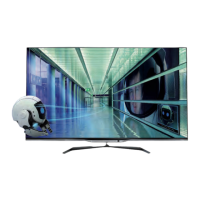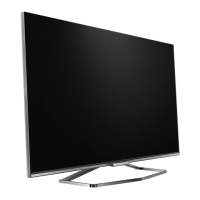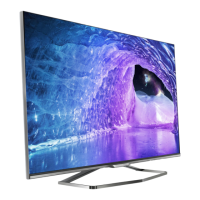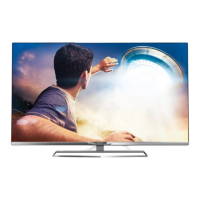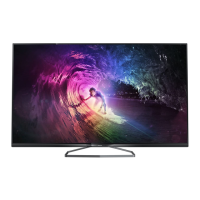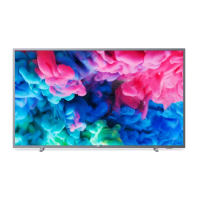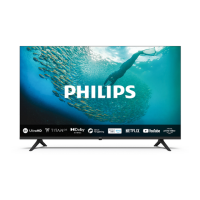Do you have a question about the Philips 42PUS7809 and is the answer not in the manual?
Details the TV's Ultra HD display resolution and pixel count.
Connects TV to the internet for various features like apps and streaming.
Browse and use apps for entertainment and convenient services on TV.
Explains how to rent movies from an online video store.
Use popular social networks like Facebook and Twitter on the TV.
Set up Philips hue lamps to follow Ambilight colours of the TV.
Make free video calls on your TV using Skype.
Pause and record TV broadcasts using a USB hard drive.
Optimize TV settings for an ideal gaming experience.
Operate connected devices with the TV remote via HDMI CEC.
Emphasizes reading all safety instructions before using the TV.
Instructions for mounting the TV stand or using a wall mount bracket.
Recommendations for optimal TV positioning and viewing distance.
Guidance on connecting and handling the TV power cable safely.
Connects antenna for DVB-T and DVB-C input signals.
Connects satellite F-type connector to the SAT input.
Connect TV wirelessly via Wi-Fi, WPS, or manual entry.
Details DHCP and Static IP settings for network setup.
Connects TV to network via Ethernet cable for internet access.
View and configure network type and IP settings (DHCP/Static).
Watch TV channels on smartphone or tablet.
Schedule TV recordings remotely via smartphone or tablet.
Rename the TV in network settings for easier identification.
Adjust specific settings for the Netflix application.
Clears internet files, app logins, and settings.
Connect devices using the highest quality connection available.
Details on HDMI connections, CEC, ARC, and Ultra HD support.
Connects component video and audio signals for HD.
Connects devices using Scart for analog video and audio.
Connects audio devices via optical cable for sound output.
Sets up EasyLink for seamless device control.
Controls connected HDMI devices using the TV remote.
Manages EasyLink features like remote control and Pixel Plus Link.
Connects and uses a Common Interface CAM module for conditional access.
Connects a set-top box using antenna and HDMI cables.
Connects a satellite receiver via antenna and HDMI cables.
Connects an HTS via HDMI or Scart for audio and video.
Uses HDMI ARC for audio return channel connection with HTS.
Adjusts audio delay to match video playback for synchronization.
Configures audio output delay, format, and levelling for HTS.
Troubleshoots sound issues when using Home Theatre Systems.
Connects and operates a Blu-ray Disc player with the TV.
Connects and operates a DVD player with the TV.
Connects a game console via HDMI or component video.
Connects, formats, and uses a USB HDD for pause/record features.
Connects and uses USB keyboards and mice for TV navigation.
Views photos, music, and videos from a connected USB flash drive.
Views Ultra HD photos from USB devices.
Connects a digital photo camera to view photos on the TV.
Connects a camcorder via HDMI for video playback.
Connects a computer to use the TV as a monitor.
Adjusts ideal monitor settings for computer input.
Connects headphones and adjusts their volume.
Turns the TV on, switches to standby, or powers it off.
Adjusts or switches off the Philips logo lighting.
Detailed explanation of all remote control buttons and their functions.
Overview of the remote control's Qwerty/Azerty and Cyrillic keyboards.
Instructions for typing text using the remote control keyboard.
Steps to pair the remote control with the TV.
Location and function of the infrared sensor for remote control.
Instructions for replacing remote control batteries.
How to clean the remote control safely and properly.
Tuning into channels using number keys, channel list, or favourites.
Viewing and navigating the channel list, including filters and renaming.
Renaming channels using the remote or onscreen keyboard.
Prevents children from watching specific channels using a lock code.
Sets age ratings to lock programmes unsuitable for children.
Accesses channel options like Universal access, Video selection, and Subtitles.
Accessing and navigating Teletext pages for information.
Various options for Teletext display like Freeze page and Enlarge.
Configures Text language and Text 2.5 settings.
Changes the language for TV menus and messages.
Selects preferred audio languages for digital TV channels.
Manages subtitle and audio language preferences.
Information on interactive TV features like HbbTV and iTV.
Updates and manages TV channel lists automatically or manually.
Reinstalls channels or performs a full TV installation.
Resets the TV to its original factory settings.
Copies channel lists between TVs for quick setup.
Sets up reception for DVB-T or DVB-C antenna signals.
Accesses and configures DVB settings like symbol rate and network frequency.
Checks signal strength and quality of digital channels.
Manually installs analogue TV channels one by one.
Tunes into satellite channels and changes them using the list.
Views and filters satellite channel lists by All, Favourites, Radio, or New.
Manages and watches favourite satellite channels.
Locks satellite channels and sets age ratings for parental control.
Sets age ratings to restrict programme access based on child's age.
Sets or changes the child lock code for parental controls.
Guides through installing satellites, including Unicable and MDU setups.
Information on satellite channel packages and subscriptions.
Restores missing channels by updating channel packages.
Detailed steps for setting up a Unicable system for satellite connection.
Adds an additional satellite to the current installation.
Removes satellites and their associated channels.
Reorders channels in favourites and renames satellite channels.
Manages automatic and manual updates for satellite channel lists.
Sets preferred languages for audio, subtitles, and Text.
Enables special audio and subtitles for hearing impaired.
Enables audio description for visually impaired users.
Installs channels from a specific transponder.
Troubleshoots issues with satellite detection and duplicate installations.
General troubleshooting steps for installation issues.
Resolves issues where all satellite channels have disappeared.
Troubleshoots channels disappearing from the list.
Explains restrictions on removing satellites.
Provides tips for improving poor satellite reception.
How to open and navigate the Home menu to access activities.
Opens the Smart TV start page for internet features.
Opens, tunes to programmes, views details, and changes days.
Records TV programmes instantly or schedules them via the TV Guide.
Finds and switches to connected devices via the Sources menu.
Operates connected devices with the TV remote via HDMI CEC.
Sets the TV to automatically switch to standby after a preset time.
Deactivates automatic TV switch-off for energy saving.
Lists requirements for watching 3D content on the TV.
Settings and tips for optimal 3D viewing and signal switching.
Precautions and warnings related to 3D viewing and glasses usage.
Connects a game console and sets TV for optimal gaming.
Plays multi-player games with split screens using 3D technology.
Views media files from USB drives or computers on the TV.
Selects and plays music files, including playlists.
Selects and plays video files, including playback controls.
Shares smartphone/tablet screens wirelessly via Miracast.
Stops screen sharing from the device or the TV.
Blocks specific devices from connecting via Miracast.
Clears the Miracast connection list to unblock devices.
Pauses and resumes digital TV broadcasts using a USB HDD.
Notes on audio description and subtitle buffering for Pause TV.
Lists requirements for recording TV programmes.
Records programmes immediately or schedules them.
Views, manages, and removes recorded programmes.
Removes recorded programmes from the list.
Introduction to making video calls on the TV via Skype.
Requirements for Skype, including camera, internet, and account.
Installs the camera and signs into Skype.
Navigates Skype menu items like Profile, People, and History.
Edits personal profile information for Skype.
Manages Skype contacts: add, accept, block, or rename.
Makes video or voice calls to Skype contacts.
Answers or declines incoming Skype calls.
Views call history, missed calls, and contact requests.
Configures Skype settings like auto sign-in, password, and video.
Restricts incoming Skype calls from specific contacts.
Forwards Skype calls to phone numbers or other Skype accounts.
Exits the Skype application on the TV.
Links to Skype's terms of use and privacy policy.
Connects TV to internet for Smart TV features like apps and streaming.
Initial configuration including registration and parental control.
Opens and uses Smart TV apps and the app gallery.
Browses and finds available apps in the gallery.
Rents movies from online video stores via Smart TV apps.
Watches missed TV programmes on demand via the Online TV app.
Watches TV channels in a small screen alongside Smart TV or Internet.
Clears internet memory to reset Smart TV connection and settings.
Watches programmes streamed from another TV in the home network.
Sets up and uses Multi Room functionality for streaming.
Shares TV content or internet sites on social networks.
Overview of MyRemote App features: SimplyShare, Control, TV guide.
Requirements for MyRemote App: home network and media server software.
Renames the TV in network settings.
Uses MyRemote App functions like SimplyShare.
Views the TV guide on a smartphone or tablet.
Uses smartphone/tablet as a TV remote control.
Watches TV channels on a smartphone or tablet.
Watches TV channels using the Wi-Fi smart screen function.
Uses the channel bar to switch TV channels.
Accesses picture format, channel lists, and other options.
Accesses and uses the main setup menu for TV settings.
Sets language, Universal access, age rating, and child lock.
Configures satellite languages and channel installation.
Connects to wired or wireless networks.
Updates TV software via USB or Internet.
Adjusts picture settings like style, colour, contrast, and sharpness.
Selects preset picture styles for easy adjustment.
Adjusts colour, contrast, and sharpness for picture quality.
Adjusts the colour saturation of the picture.
Adjusts the picture contrast.
Adjusts the level of picture sharpness.
Fine-tunes picture settings like colour, contrast, and sharpness.
Adjusts contrast modes for power saving or picture intensity.
Enhances picture details in dark, middle, and light areas.
Adjusts the overall brightness level of the picture.
Adjusts sharpness, ultra resolution, and noise reduction.
Smooths digital transitions and reduces image artefacts.
Adjusts motion settings like Natural Motion and Clear LCD.
Sets TV for ideal game or computer viewing modes.
Configures sound settings like style, bass, treble, and surround.
Adjusts Bass, Treble, Surround Mode, and Auto Surround 3D.
Adjusts volume for connected headphones separately.
Configures Auto Volume Levelling and TV Speakers.
Selects audio output source (TV speakers or connected audio device).
Improves speech clarity for news and dialogue.
Switches the HDMI ARC signal on or off.
Sets the audio output format for Home Theatre Systems.
Sets TV audio offset when HTS cannot set its own sync.
Adjusts Ambilight style, brightness, saturation, and hue.
Sets up Philips hue lamps to follow Ambilight colours.
Configures individual Philips hue bulbs for Ambilight+hue.
Enables features for hearing and visually impaired users.
Enables special audio and subtitles for hearing impaired.
Enables audio description for visually impaired users.
Mixes normal audio with audio commentary volume.
Enables audio feedback for remote control key presses.
Information on saving energy, screen off, light sensor, and switch off timer.
Disposal instructions for the product and batteries.
Technical specifications for receiving satellite TV signals.
Screen size, resolution, and supported input resolutions.
Power specifications, ambient temperature, and consumption.
Physical dimensions and weights of the TV models.
Overview of rear and side TV connections.
Audio output power specifications.
Supported media file formats, codecs, and USB file systems.
Updates TV software via USB or Internet.
Views the current TV software version.
Information about open source software included in the TV.
Acknowledgements and license texts for open source software.
General troubleshooting for channels, power, and remote control issues.
Troubleshoots picture issues like no picture, distortion, or incorrect fit.
Troubleshoots connection issues for HDMI, EasyLink, and USB devices.
Accesses on-screen help and downloads the user manual.
Consults online support for troubleshooting Philips TV problems.
Contacts Consumer Care for support and repair services.
Important safety instructions before using the TV.
Precautions to prevent electric shock or fire hazards.
Precautions to prevent children from pulling the TV over.
Disconnects TV during lightning storms to prevent damage.
Instructions for cleaning and caring for the TV screen.
Legal terms and conditions for using the product and manual.
Information on HDMI, Dolby, DTS, and other trademarks.
Trademarks and licensing information related to Skype.
Content access technology and usage restrictions.
Contact details for Argentina.
Contact details for Brazil.
Contact details for France.
Contact details for Germany.
Contact details for Italy.
Contact details for Portugal.
Contact details for the United Kingdom.
Details the TV's Ultra HD display resolution and pixel count.
Connects TV to the internet for various features like apps and streaming.
Browse and use apps for entertainment and convenient services on TV.
Explains how to rent movies from an online video store.
Use popular social networks like Facebook and Twitter on the TV.
Set up Philips hue lamps to follow Ambilight colours of the TV.
Make free video calls on your TV using Skype.
Pause and record TV broadcasts using a USB hard drive.
Optimize TV settings for an ideal gaming experience.
Operate connected devices with the TV remote via HDMI CEC.
Emphasizes reading all safety instructions before using the TV.
Instructions for mounting the TV stand or using a wall mount bracket.
Recommendations for optimal TV positioning and viewing distance.
Guidance on connecting and handling the TV power cable safely.
Connects antenna for DVB-T and DVB-C input signals.
Connects satellite F-type connector to the SAT input.
Connect TV wirelessly via Wi-Fi, WPS, or manual entry.
Details DHCP and Static IP settings for network setup.
Connects TV to network via Ethernet cable for internet access.
View and configure network type and IP settings (DHCP/Static).
Watch TV channels on smartphone or tablet.
Schedule TV recordings remotely via smartphone or tablet.
Rename the TV in network settings for easier identification.
Adjust specific settings for the Netflix application.
Clears internet files, app logins, and settings.
Connect devices using the highest quality connection available.
Details on HDMI connections, CEC, ARC, and Ultra HD support.
Connects component video and audio signals for HD.
Connects devices using Scart for analog video and audio.
Connects audio devices via optical cable for sound output.
Sets up EasyLink for seamless device control.
Controls connected HDMI devices using the TV remote.
Manages EasyLink features like remote control and Pixel Plus Link.
Connects and uses a Common Interface CAM module for conditional access.
Connects a set-top box using antenna and HDMI cables.
Connects a satellite receiver via antenna and HDMI cables.
Connects an HTS via HDMI or Scart for audio and video.
Uses HDMI ARC for audio return channel connection with HTS.
Adjusts audio delay to match video playback for synchronization.
Configures audio output delay, format, and levelling for HTS.
Troubleshoots sound issues when using Home Theatre Systems.
Connects and operates a Blu-ray Disc player with the TV.
Connects and operates a DVD player with the TV.
Connects a game console via HDMI or component video.
Connects, formats, and uses a USB HDD for pause/record features.
Connects and uses USB keyboards and mice for TV navigation.
Views photos, music, and videos from a connected USB flash drive.
Views Ultra HD photos from USB devices.
Connects a digital photo camera to view photos on the TV.
Connects a camcorder via HDMI for video playback.
Connects a computer to use the TV as a monitor.
Adjusts ideal monitor settings for computer input.
Connects headphones and adjusts their volume.
Turns the TV on, switches to standby, or powers it off.
Adjusts or switches off the Philips logo lighting.
Detailed explanation of all remote control buttons and their functions.
Overview of the remote control's Qwerty/Azerty and Cyrillic keyboards.
Instructions for typing text using the remote control keyboard.
Steps to pair the remote control with the TV.
Location and function of the infrared sensor for remote control.
Instructions for replacing remote control batteries.
How to clean the remote control safely and properly.
Tuning into channels using number keys, channel list, or favourites.
Viewing and navigating the channel list, including filters and renaming.
Renaming channels using the remote or onscreen keyboard.
Prevents children from watching specific channels using a lock code.
Sets age ratings to lock programmes unsuitable for children.
Accesses channel options like Universal access, Video selection, and Subtitles.
Accessing and navigating Teletext pages for information.
Various options for Teletext display like Freeze page and Enlarge.
Configures Text language and Text 2.5 settings.
Changes the language for TV menus and messages.
Selects preferred audio languages for digital TV channels.
Manages subtitle and audio language preferences.
Information on interactive TV features like HbbTV and iTV.
Updates and manages TV channel lists automatically or manually.
Reinstalls channels or performs a full TV installation.
Resets the TV to its original factory settings.
Copies channel lists between TVs for quick setup.
Sets up reception for DVB-T or DVB-C antenna signals.
Accesses and configures DVB settings like symbol rate and network frequency.
Checks signal strength and quality of digital channels.
Manually installs analogue TV channels one by one.
Tunes into satellite channels and changes them using the list.
Views and filters satellite channel lists by All, Favourites, Radio, or New.
Manages and watches favourite satellite channels.
Locks satellite channels and sets age ratings for parental control.
Sets age ratings to restrict programme access based on child's age.
Sets or changes the child lock code for parental controls.
Guides through installing satellites, including Unicable and MDU setups.
Information on satellite channel packages and subscriptions.
Restores missing channels by updating channel packages.
Detailed steps for setting up a Unicable system for satellite connection.
Adds an additional satellite to the current installation.
Removes satellites and their associated channels.
Reorders channels in favourites and renames satellite channels.
Manages automatic and manual updates for satellite channel lists.
Sets preferred languages for audio, subtitles, and Text.
Enables special audio and subtitles for hearing impaired.
Enables audio description for visually impaired users.
Installs channels from a specific transponder.
Troubleshoots issues with satellite detection and duplicate installations.
General troubleshooting steps for installation issues.
Resolves issues where all satellite channels have disappeared.
Troubleshoots channels disappearing from the list.
Explains restrictions on removing satellites.
Provides tips for improving poor satellite reception.
How to open and navigate the Home menu to access activities.
Opens the Smart TV start page for internet features.
Opens, tunes to programmes, views details, and changes days.
Records TV programmes instantly or schedules them via the TV Guide.
Finds and switches to connected devices via the Sources menu.
Operates connected devices with the TV remote via HDMI CEC.
Sets the TV to automatically switch to standby after a preset time.
Deactivates automatic TV switch-off for energy saving.
Lists requirements for watching 3D content on the TV.
Settings and tips for optimal 3D viewing and signal switching.
Precautions and warnings related to 3D viewing and glasses usage.
Connects a game console and sets TV for optimal gaming.
Plays multi-player games with split screens using 3D technology.
Views media files from USB drives or computers on the TV.
Selects and plays music files, including playlists.
Selects and plays video files, including playback controls.
Shares smartphone/tablet screens wirelessly via Miracast.
Stops screen sharing from the device or the TV.
Blocks specific devices from connecting via Miracast.
Clears the Miracast connection list to unblock devices.
Pauses and resumes digital TV broadcasts using a USB HDD.
Notes on audio description and subtitle buffering for Pause TV.
Lists requirements for recording TV programmes.
Records programmes immediately or schedules them.
Views, manages, and removes recorded programmes.
Removes recorded programmes from the list.
Introduction to making video calls on the TV via Skype.
Requirements for Skype, including camera, internet, and account.
Installs the camera and signs into Skype.
Navigates Skype menu items like Profile, People, and History.
Edits personal profile information for Skype.
Manages Skype contacts: add, accept, block, or rename.
Makes video or voice calls to Skype contacts.
Answers or declines incoming Skype calls.
Views call history, missed calls, and contact requests.
Configures Skype settings like auto sign-in, password, and video.
Restricts incoming Skype calls from specific contacts.
Forwards Skype calls to phone numbers or other Skype accounts.
Exits the Skype application on the TV.
Links to Skype's terms of use and privacy policy.
Connects TV to internet for Smart TV features like apps and streaming.
Initial configuration including registration and parental control.
Opens and uses Smart TV apps and the app gallery.
Browses and finds available apps in the gallery.
Rents movies from online video stores via Smart TV apps.
Watches missed TV programmes on demand via the Online TV app.
Watches TV channels in a small screen alongside Smart TV or Internet.
Clears internet memory to reset Smart TV connection and settings.
Watches programmes streamed from another TV in the home network.
Sets up and uses Multi Room functionality for streaming.
Shares TV content or internet sites on social networks.
Overview of MyRemote App features: SimplyShare, Control, TV guide.
Requirements for MyRemote App: home network and media server software.
Renames the TV in network settings.
Uses MyRemote App functions like SimplyShare.
Views the TV guide on a smartphone or tablet.
Uses smartphone/tablet as a TV remote control.
Watches TV channels on a smartphone or tablet.
Watches TV channels using the Wi-Fi smart screen function.
Uses the channel bar to switch TV channels.
Accesses picture format, channel lists, and other options.
Accesses and uses the main setup menu for TV settings.
Sets language, Universal access, age rating, and child lock.
Configures satellite languages and channel installation.
Connects to wired or wireless networks.
Updates TV software via USB or Internet.
Adjusts picture settings like style, colour, contrast, and sharpness.
Selects preset picture styles for easy adjustment.
Adjusts colour, contrast, and sharpness for picture quality.
Adjusts the colour saturation of the picture.
Adjusts the picture contrast.
Adjusts the level of picture sharpness.
Fine-tunes picture settings like colour, contrast, and sharpness.
Adjusts contrast modes for power saving or picture intensity.
Enhances picture details in dark, middle, and light areas.
Adjusts the overall brightness level of the picture.
Adjusts sharpness, ultra resolution, and noise reduction.
Smooths digital transitions and reduces image artefacts.
Adjusts motion settings like Natural Motion and Clear LCD.
Sets TV for ideal game or computer viewing modes.
Configures sound settings like style, bass, treble, and surround.
Adjusts Bass, Treble, Surround Mode, and Auto Surround 3D.
Adjusts volume for connected headphones separately.
Configures Auto Volume Levelling and TV Speakers.
Selects audio output source (TV speakers or connected audio device).
Improves speech clarity for news and dialogue.
Switches the HDMI ARC signal on or off.
Sets the audio output format for Home Theatre Systems.
Sets TV audio offset when HTS cannot set its own sync.
Adjusts Ambilight style, brightness, saturation, and hue.
Sets up Philips hue lamps to follow Ambilight colours.
Configures individual Philips hue bulbs for Ambilight+hue.
Enables features for hearing and visually impaired users.
Enables special audio and subtitles for hearing impaired.
Enables audio description for visually impaired users.
Mixes normal audio with audio commentary volume.
Enables audio feedback for remote control key presses.
Information on saving energy, screen off, light sensor, and switch off timer.
Disposal instructions for the product and batteries.
Technical specifications for receiving satellite TV signals.
Screen size, resolution, and supported input resolutions.
Power specifications, ambient temperature, and consumption.
Physical dimensions and weights of the TV models.
Overview of rear and side TV connections.
Audio output power specifications.
Supported media file formats, codecs, and USB file systems.
Updates TV software via USB or Internet.
Views the current TV software version.
Information about open source software included in the TV.
Acknowledgements and license texts for open source software.
General troubleshooting for channels, power, and remote control issues.
Troubleshoots picture issues like no picture, distortion, or incorrect fit.
Troubleshoots connection issues for HDMI, EasyLink, and USB devices.
Accesses on-screen help and downloads the user manual.
Consults online support for troubleshooting Philips TV problems.
Contacts Consumer Care for support and repair services.
Important safety instructions before using the TV.
Precautions to prevent electric shock or fire hazards.
Precautions to prevent children from pulling the TV over.
Disconnects TV during lightning storms to prevent damage.
Instructions for cleaning and caring for the TV screen.
Legal terms and conditions for using the product and manual.
Information on HDMI, Dolby, DTS, and other trademarks.
Trademarks and licensing information related to Skype.
Content access technology and usage restrictions.
Contact details for Argentina.
Contact details for Brazil.
Contact details for France.
Contact details for Germany.
Contact details for Italy.
Contact details for Portugal.
Contact details for the United Kingdom.
| Screen Size | 42 inches |
|---|---|
| Display Technology | LED |
| Smart TV | Yes |
| Operating System | Android |
| Refresh Rate | 60 Hz |
| HDMI Ports | 4 |
| USB Ports | 3 |
| Wi-Fi | Yes |
| Bluetooth | Yes |
| Ambilight | Yes |
| Resolution | 3840 x 2160 (4K UHD) |
| HDR | Yes |
| Digital TV Tuner | DVB-T2/C/S2 |

